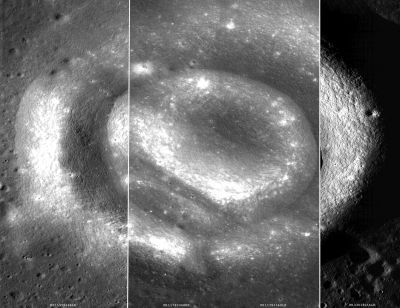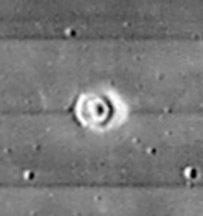Marth
Contents
Marth
|
Lat: 31.18°S, Long: 29.39°W, Diam: 6.52 km, Depth: 1.07 km, Rükl 63 | |

Left: LROC NAC mosaic (image no's. M135379494LE, M111783348RE, M111783348LE, M133018216LE) of Marth. Note, as both the eastern and western NAC images in the triptych above were taken at different dates during the spacecraft's orbit, the lighting conditions aren't the same, however, alignment and feature proportions have been maintained.
Right: LO-VI136-h3
Bottom: LROC mosaic of three different lightings.
Images
LPOD Photo Gallery Lunar Orbiter Images Apollo Images
- Marth, the 27th item in C.A.Wood's list of Concentric Craters (1978), shows a curious non-circular shape on the Hi-Res scan of Lunar Orbiter 4's photograph LOIV-136-h3. Marth is located near the frame's right margin (about "halfway"). Note also the curious "N"-shaped system of Rimae Ramsden, north of Ramsden itself and west-southwest of Marth.
- Research: Danny Caes
Maps
(LAC zone 94D4) LAC map Geologic map
Description
Wikipedia
Additional Information
- IAU page: Marth
- Depth data from Kurt Fisher database
- Westfall, 2000: 1.07 km
- The second most famous Concentric Crater (or possible Concentric Crater) is Marth. The first most famous Concentric Crater is Hesiodus A.
- Is there a ghost crater just west of Marth? See LRO photograph Marth (discovered by A.Božič).
- The suspected ghost-crater just west of Marth (about halfway between Marth and the triangle of hillocks Marth Alpha, Beta, and Gamma) is quite an interesting target to investigate. Only the east-northeastern part of its rim is visible, and perhaps also a very vague trace of the west-southwestern part (note: orbital photographs made during very low sun are needed!). - DannyCaes Jan 10, 2016
- East-northeast of Marth, about halfway between Marth and Mercator, is the location of the bowl-shaped crater Mercator A which shows a remarkable system of dark bands on its inner slopes, looking very much like a dark X. This crater is nicknamed the X-crater by D.Caes.
Nomenclature
- Named for Albert Marth (May 5, 1828–August 5, 1897), a German astronomer who worked in England and Ireland. He came to England in 1853 to work for George Bishop, a patron of astronomy. At that time, paid jobs in astronomy were quite rare. He worked as William Lassell's assistant in Malta, discovering 600 nebulae.
- Three small hillocks west of Marth, arranged in the shape of a triangle, are unofficially known as Marth Alpha, Marth Beta, and Marth Gamma (see page 207 in Tony Dethier's Maanmonografieen).
LPOD Articles
- More Marth
- Is Marth a Concentric Crater?
- How He Does It (the Marth/ Ramsden sector, by Leo Aerts).
Bibliography
- Hill, Harold. 1991. A Portfolio of Lunar Drawings., pages 154, 155 (the western portion of Palus Epidemiarum).
Named Features -- Prev: Markov -- Next: Mary

